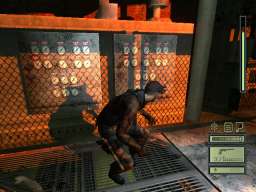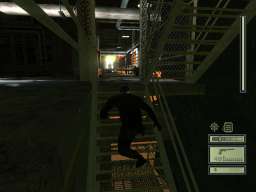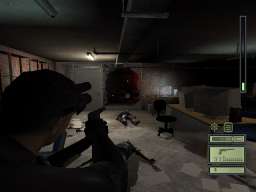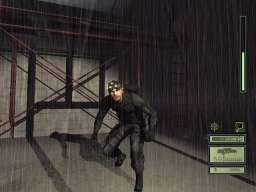


Tom Clancy's Splinter Cell from Ubi Soft is an intense tactical combat title
that features amazing graphics, sophisticated weapons and a realistic plot. You
to take control of a Special Operations soldier and your mission is to unravel
and destroy a terrorist cell that threatens freedom. The controls are excellent
and the environments are richly detailed, but does Splinter Cell have what it
takes to dethrone Metal Gear Solid as the best stealth action game? The Laser
goes deep undercover to find out.
Splinter Cell is set in the near future and
places you in the role of an agent working for a mysterious agency. You are in
the realm of high-stakes espionage, where shadowy operatives have the freedom to
do whatever it takes to safeguard America, including assassinations and
sabotage. Your name is Sam Fisher, a field operative for the National Security
Agency. Fisher works for a secretive organization named Third Echelon. You're
sent to investigate a series of events that led to the apparent murder of an
agent in an Eastern European nation. Fisher finds out that the murders are
involved with terrorist organization is trying to assemble bio and nuclear
weapons. Fischer's mission is to take out Third Echelon without causing a major
incident. If he's caught in the act, kills too many civilians, or fails to
complete his mission objectives, the agency will deny any knowledge of his
existence.
The stakes are high but you should have the skills and tools to get the job
done. Splinter Cell's design is quite sophisticated and allows the player to
complete objectives without having to follow a set path. Splinter Cell's
missions are challenging with an excellent balance of stealth, action and
complicated puzzles that require skills and brainpower. There's an excellent
pace to the storyline and missions that keeps your interest level high
throughout. The non-linear approach makes Splinter Cell seem even more
realistic. During the game, players will find additional health, ammo and
weapons that can be picked up. Splinter Cell's environments are large and
players will spend a lot of time exploring them, which can result in finding
secret paths and other ways around. Luckily, there are frequent save points that
prevent you from doing too much tedious backtracking.
Fisher has a number of stealth tactics and moves that he can use that will allow
him to complete the missions that are integral to the gameplay. The most
important thing is to keep his cover. Players need to keep him in the darkness
and avoid direct confrontations or being detected by cameras. An onscreen light
indicator in the HUD shows how visible he is, allowing you to keep his exposure
to a minimum. In many areas of the game, he can hide behind objects and can roll
around and crouch to stay out of sight. Fisher can also shimmy along edges and
ledges, glide through zip lines, jump off walls and peek around corners. Simply
moving around creates noise and this also tips off enemies to his presence. You
need to familiarize yourself by understanding which surfaces make the most
noise. He also has other tactics in addition to staying in the shadows to stay
out of view. He can climb ladders and pipes, hang over gaps, or sneak through
tight areas by walking with his back against a wall.
Additional tactics available to players include the ability to climb
hand-over-hand while hanging from a pipe and can wrap his legs around these so
they don't dangle and tip off the enemies. When he's lurking in the shadows, he
can jump onto or sneak up behind enemies to disable them. If he catches them
off-guard he'll hold them, at which point he can do a number of things. Fisher
can force them to co-operate in order extract information, use them as human
shields in some situations or can simply knock them out or kill them. Once these
enemies have been neutralized, their presence may also tip off guards to his
existence. He can pick up and remove the bodies of fallen foes and carry them
into the shadows, safely out of sight. These stealth abilities are quite
impressive and the implementation is sterling.
 Splinter
Cell's weapons and gadgets consist of real-world and prototype devices. Fisher's
basic arsenal includes a standard pistol, which is effective and simple to use.
He is also equipped with special goggles that allow him to view the action in
either Thermal or Night Vision modes. Night Vision lights up the screen and is
used to spot enemies lurking in the darkness while the Thermal mode uses body
heat to see enemies who may be hiding behind doors. The google effects are only
enhanced by Splinter Cell's outstanding camera system which allows you to use
them while moving. The camera system has been integrated seamlessly with the
other controls, allowing you to change viewpoints and look around intuitively.
Fisher's other main device is his OPSAT that displays mission objectives and
other important information. The OPSAT is one of the coolest things in the game,
and players should refer to it often. Other weapons at his disposal include
assault rifles, sniper guns, flares, missile launchers, gas grenades, shockers,
and projectile missiles that incapacitate enemies. Fisher can also use sticky
mini-cameras and time bombs on walls that can hurt unsuspecting enemies. The
Lock Pick is used to open sealed doors, though using this can be a bit tricky.
Later on, the player will get an Optical Camera with night-vision abilities. He
can use this device to see underneath doors to see what's happening on the other
side of them. These are all impressive and useful devices and their ease of use
and utility allows them to be effective, rather than gimmicks.
Splinter
Cell's weapons and gadgets consist of real-world and prototype devices. Fisher's
basic arsenal includes a standard pistol, which is effective and simple to use.
He is also equipped with special goggles that allow him to view the action in
either Thermal or Night Vision modes. Night Vision lights up the screen and is
used to spot enemies lurking in the darkness while the Thermal mode uses body
heat to see enemies who may be hiding behind doors. The google effects are only
enhanced by Splinter Cell's outstanding camera system which allows you to use
them while moving. The camera system has been integrated seamlessly with the
other controls, allowing you to change viewpoints and look around intuitively.
Fisher's other main device is his OPSAT that displays mission objectives and
other important information. The OPSAT is one of the coolest things in the game,
and players should refer to it often. Other weapons at his disposal include
assault rifles, sniper guns, flares, missile launchers, gas grenades, shockers,
and projectile missiles that incapacitate enemies. Fisher can also use sticky
mini-cameras and time bombs on walls that can hurt unsuspecting enemies. The
Lock Pick is used to open sealed doors, though using this can be a bit tricky.
Later on, the player will get an Optical Camera with night-vision abilities. He
can use this device to see underneath doors to see what's happening on the other
side of them. These are all impressive and useful devices and their ease of use
and utility allows them to be effective, rather than gimmicks.
Splinter Cell's controls are intuitive and allow Fisher's dexterity to shine
through. You use the main analog stick to move while the secondary analog stick
controls the camera. Jumping and climbing are easy to perfom. In order to take a
guard out, you only need sneak behind them and press the A button. At this
point, Fisher holds them can knock them out or extract information. Picking up
bodies is likewise intuitive, and makes moving the bodies to another location
easier than it sounds. At many points in the game, you can interact with objects
simply by pressing the A button. This may not sound like a big deal, but the
consistent interface makes playing Splinter Cell incredibly intuitive. Firing
your gun requires you to equip it then you target the shots using the analog
stick. Pulling up the inventory screen allows you to change weapons or use
health kits, and is easy to understand. Each gadget has its own mechanism and
work seamlessly into the standard controls. Splinter Cell's almost transparent
controls are incredibly impressive, offering both versatility and simplicity.
 Splinter
Cell's breathtaking visuals set a new high-water mark on the Xbox. No title has
approached the level of realism that this title achieves from the moment you
begin. Splinter Cell's large levels are amazing with incredible detail
throughout. The dynamic lighting effects allow shadows to seep through complex
objects such as ornate fences creating multi-tiered shadows rich with a subtlety
and nuance. There is an amazing level of detail in many of the game's objects,
giving it an unprecedented visual polish. Muted colors and darkness make
Splinter Cell's dark environments appear photo-realistic. Fisher himself looks
lifelike with his face-stubble making him seem almost alive. Splinter Cell's
animation is outstanding as well, making you feel like you're controlling an
actual agent. These environments are all the more impressive because they're
fully interactive. You can grab bottles or soda cans and throw them to distract
enemies, shoot out lights and move paintings to find hidden safes. The audio is
also implemented brilliantly and adds to Splinter Cell's tension and suspense.
While in some areas, the music is non-existent, it swells and becomes
increasingly agitated when major events occur brilliantly underscoring the
action. The production values are highly polished with an unprecedented level of
detail that increases your immersion and lends it a sleek realism.
Splinter
Cell's breathtaking visuals set a new high-water mark on the Xbox. No title has
approached the level of realism that this title achieves from the moment you
begin. Splinter Cell's large levels are amazing with incredible detail
throughout. The dynamic lighting effects allow shadows to seep through complex
objects such as ornate fences creating multi-tiered shadows rich with a subtlety
and nuance. There is an amazing level of detail in many of the game's objects,
giving it an unprecedented visual polish. Muted colors and darkness make
Splinter Cell's dark environments appear photo-realistic. Fisher himself looks
lifelike with his face-stubble making him seem almost alive. Splinter Cell's
animation is outstanding as well, making you feel like you're controlling an
actual agent. These environments are all the more impressive because they're
fully interactive. You can grab bottles or soda cans and throw them to distract
enemies, shoot out lights and move paintings to find hidden safes. The audio is
also implemented brilliantly and adds to Splinter Cell's tension and suspense.
While in some areas, the music is non-existent, it swells and becomes
increasingly agitated when major events occur brilliantly underscoring the
action. The production values are highly polished with an unprecedented level of
detail that increases your immersion and lends it a sleek realism.
The comparisons between Splinter Cell and
Metal Gear Solid 2 are obvious, with both titles featuring a lone protagonist
engaged in stealth missions. However, there are major differences in philosophy
and design that should allow this title to stand on it's own. For example, while
there was a on-screen radar in Metal Gear Solid that allowed you to see what was
in the next room, in Splinter Cell, the player has no idea what lurks behind
each locked door and needs to use the Optical Camera. This is a big difference
and the grounding in reality makes all the difference in its appeal. Splinter
Cell's plot and characters are more believable than the bizarre storyline that
hampered MGS2. While the graphics are amazing, what really makes the game stand
out are its real-world devices and techniques. As opposed to fantasy weapons and
boss creatures that seem to have no relation to the reality. In the end, it's
this realism in all departments and the flawless implementation that sets the
game apart.
Splinter Cell excels in many areas and
delivers what is probably the most heart-pounding action title ever seen on a
console. Only a handful of games have come as close to photo-realism as Splinter
Cell and the visuals are some of the most amazing seen on the Xbox or any other
conosle. The game's pace is almost perfect, and it unfolds at with a good
mixture of stealth and action that creates tension and excitement, immersing you
into its engaging storyline and interesting characters. Splinter Cell's realism
and stealth makes for quite an intense experience with all the tension of a
real-world spy mission. The intuitive controls make it easy to control Fisher
and perform some spectacular moves and stunts. Splinter Cell is an amazing
achievement that delivers on the promise and then some. It's probably the best
Xbox title this year and should not be missed by any gamer.
> Related Reviews
Ghost Recon: Island Thunder (PC)
MechAssault (Xbox)
Unreal Championship (Xbox)
SOCOM: US Navy Seals (PS2)

